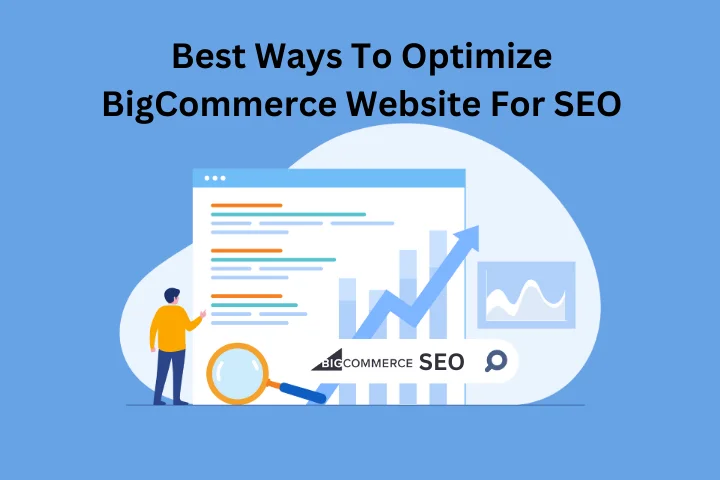1. Introduction
Your BigCommerce website speed matters a lot. The loading speed of any store is of significant importance. You can not neglect it. Each time we enter a query, we expect the result to appear instantly. But many times website takes too long to load, which directly impacts its ranking, user experience, and many other factors.
Therefore, to boost the speed of your BigCommerce store, we came up with this blog. In this website speed optimization blog, we will explore the benefits and things that cause slow loading speed, and last, we will get to know the website speed optimization techniques.
2. How Does A Poor Loading Website Impacts Business Performance?
Here, we have mentioned the things and components a slow-loading website affects.
Decreased User Engagement and High Bounce Rates
Slow-loading website frustrates visitors, causing them to leave quickly. High bounce rates signal search engines that your site doesn’t meet user needs, leading to decreased visibility in search results. Therefore you have to implement effective strategies to reduce bounce rates.
Adverse Impact on Search Engine Rankings
A slow website can lead to lower search engine rankings, making it difficult for potential customers to find your store online.
Negative Impact on Conversion Rates
Slow-loading pages diminish user trust and confidence. When visitors lack trust, they are less likely to make a purchase, leading to a decrease in conversion rates and, consequently, sales.
Poor Mobile Experience
Mobile users are increasing exponentially. A slow website can ruin the mobile user experience, leading to missed opportunities as a significant portion of online shoppers browse and buy through mobile devices.
Increased Cart Abandonment Rates
When a website takes too long to load, potential customers may abandon their shopping carts in frustration. This phenomenon directly impacts revenue and leads to lost sales opportunities.
Higher Customer Service Requests
Customers experiencing slow-loading pages may seek assistance from customer service, leading to an increase in support requests. This strains customer service resources and can hamper the overall customer experience.
Negative Impact on Brand Reputation
A slow website reflects poorly on your brand. In the age of instant gratification, customers expect websites to load swiftly. A slow site can damage your brand’s reputation and make customers hesitant to engage with your business.
Increased Hosting Costs
Ignoring website speed can lead to increased hosting costs. To compensate for slow loading, store owners might invest in more expensive hosting solutions, impacting their budget without solving the underlying problem.
Limited Scalability
A slow website hampers scalability. As your business grows, a sluggish site might not handle increased traffic, leading to downtime and lost sales during peak periods.
Missed SEO Opportunities
Slow-loading websites hinder search engine crawlers’ ability to index content efficiently. This can lead to missed SEO opportunities, affecting the site’s overall visibility and organic traffic.
These are the things that a slow-loading website causes. It impacts various elements of your BigCommerce store.

Want to read this blog offline?
No worries, download the PDF version
now and enjoy your reading later…
3. Benefits of A Fast-Loading BigCommerce Website
These are the advantages of fast-loading website speed.
Enhances User Experience
A fast-loading website ensures visitors find the information they seek quickly, enhancing user satisfaction and encouraging them to stay longer.
Reduces Bounce Rate
Slow websites lead to high bounce rates, where visitors leave your site prematurely. Optimizing speed keeps visitors engaged, reducing bounce rates significantly.
Improves Search Engine Rankings
Faster websites are more likely to rank higher in search engine results pages, driving organic traffic. Improving site speed is one of the best ways to increase organic traffic on your BigCommerce store.
Boosts Conversion Rates
Speedy websites create a seamless browsing experience, boosting trust and increasing the likelihood of conversions, whether it’s making a purchase, filling out a form, or subscribing.
Enhances Mobile Experience
With the rise of mobile users, optimizing website speed is essential for mobile-friendliness. Mobile-optimized, fast-loading websites cater to a broader audience.
Saves Bandwidth and Hosting Costs
Optimized websites use fewer server resources, saving bandwidth and hosting costs. This optimization is especially crucial for businesses with limited budgets.
Encourages Social Sharing
Fast-loading pages make it convenient for visitors to share your content on social media platforms.
Improves Server Response Time
Website speed optimization includes improving server response time, ensuring that your website swiftly responds to user requests, and enhancing overall user experience.
Increases Crawl Rate for SEO
Search engine bots crawl websites faster when they load quickly. This increased crawl rate ensures search engines index your content promptly, positively impacting SEO.
Reduces Cart Abandonment
For e-commerce websites, speed is directly related to sales. Faster checkouts and product page loading reduce cart abandonment rates, boosting revenue.
Enhances User Engagement
Fast websites enable interactive features like chat support and real-time notifications, enhancing user engagement and building a loyal customer base.
Improves Time on Site
When users can navigate swiftly, they spend more time exploring your website. Increased time on site indicates user interest and engagement.
Facilitates Better User Interaction
Interactive elements such as quizzes, polls, and surveys function seamlessly on fast-loading websites, encouraging user interaction and feedback.
Ensures Better User Retention
Users are more likely to return to a website that provides a hassle-free experience. Speed optimization contributes significantly to user retention rates.
Enhances Overall Brand Reputation
A website that loads quickly reflects positively on your brand. It portrays professionalism and reliability, enhancing your brand’s reputation.
These are the benefits of a fast-loading website.
Speed Up Your BigCommerce Store for Big Results!
Boost Website Speed Now4. BigCommerce Site Speed Optimization Techniques
These are the top BigCommerce site speed optimization strategies that will help your brand improve its website loading speed.
Optimize Images and Graphics
High-resolution images can significantly slow down your website. Compress images without compromising quality using tools like Photoshop or online platforms like TinyPNG.
Minimize HTTP Requests
Reduce the number of elements on your web pages, such as scripts, images, and stylesheets. Each element requires a separate HTTP request, impacting loading time.
Utilize Browser Caching
Leverage browser caching to store frequently accessed resources on visitors’ devices. This reduces the need to reload assets, speeding up subsequent visits.
Enable Gzip Compression
Enable Gzip compression on your server to reduce file sizes before they are sent to the browser. Smaller files mean quicker loading times for users.
Minify CSS, JavaScript, and HTML
Minification involves removing unnecessary characters and spaces from your code. Smaller files load faster, optimizing your website’s speed.
Use Content Delivery Networks (CDNs)
CDNs store copies of your website’s files on multiple servers worldwide. When a user accesses your site, they download files from the nearest server, reducing latency and improving loading times.
Opt for Reliable Hosting
Choose a reputable hosting provider that offers optimized servers and excellent uptime. A reliable host ensures your website is consistently accessible to users.
Implement Lazy Loading
Lazy loading defers the loading of non-critical resources (like images below the fold) until users scroll down, enhancing the initial loading speed.
Reduce Server Response Time
Optimize your web server and database queries to minimize the time it takes to respond to user requests. Efficient server responses are key to a speedy website.
Prioritize Above-the-Fold Content
Load essential above-the-fold content first, allowing users to see and interact with the primary elements of your page while the rest of the site continues to load in the background.
Utilize Accelerated Mobile Pages (AMP)
AMP is a Google-backed project designed to create fast-loading mobile pages. Implementing AMP ensures your website provides a seamless experience on mobile devices.
Optimize Database
If your website relies on a database, optimize it by removing unnecessary data, reducing table overhead, and ensuring efficient queries.
Monitor Website Performance
Regularly monitor your website’s performance using tools like Google PageSpeed Insights or GTmetrix. These tools provide valuable insights and suggestions for further optimizations.
Limit External Embedded Media
External media like videos and widgets can significantly impact loading times. Limit their use or use lightweight alternatives to enhance your website’s speed.
Conclusion
In this blog, we have explained the benefits of a fast-loading website. Additionally, we have explained the reasons behind a slow-loading website and how it impacts the other factors of their website. So, to avoid any issue you can also opt for a BigCommerce site speed optimization tool such as Website Speedy. Website Speedy is a SaaS-based tool that does multiple tasks to make your website load instantly and fast.
Website Speedy performs tasks such as render-blocking to increase your website speed. With the expertise of this tool, you will be able to improve the ranking and speed of your ecommerce website.
October 16, 2023
Leave a Comment


































